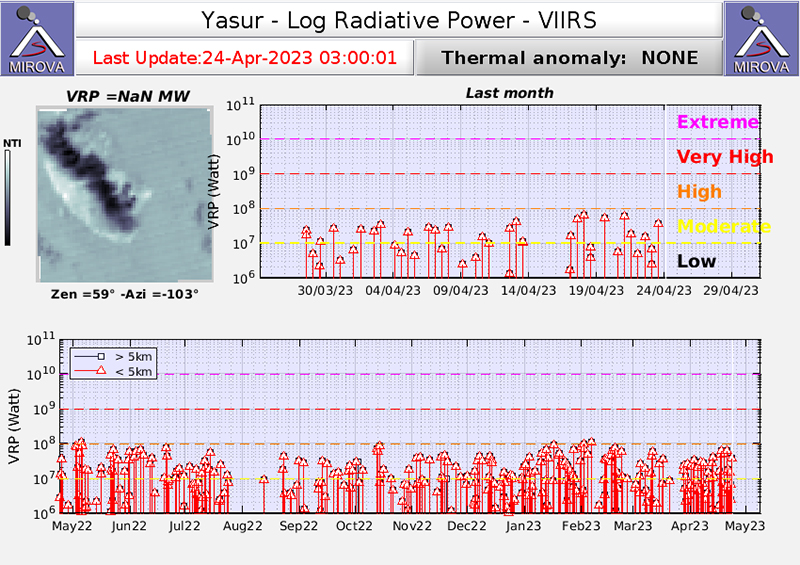Report on Yasur (Vanuatu) — May 2023
Bulletin of the Global Volcanism Network, vol. 48, no. 5 (May 2023)
Managing Editor: Edward Venzke.
Research and preparation by Paul Berger.
Yasur (Vanuatu) Ongoing summit crater activity with thermal anomalies, explosions, and SO2 plumes through April 2023
Please cite this report as:
Global Volcanism Program, 2023. Report on Yasur (Vanuatu) (Venzke, E., ed.). Bulletin of the Global Volcanism Network, 48:5. Smithsonian Institution.
Yasur
Vanuatu
19.532°S, 169.447°E; summit elev. 361 m
All times are local (unless otherwise noted)
Yasur on Tanna Island, the southernmost active volcano in Vanuatu, has been erupting since at least 1774 if not before, with frequent Strombolian explosions and ash and gas plumes from several vents in the 400-m-diameter summit crater (BGVN 47:09). This report summarizes activity during September 2022-April 2023, using information from monthly bulletins of the Vanuatu Meteorology and Geo-Hazards Department (VMGD) and various satellite data. According to VMGD, Yasur has remained on Alert Level 2 (major unrest state, on a scale of 0-5) since 18 October 2016, and VMGD warned the public not to enter the restricted area within a radius of 600 m around the cone.
According to VMGD, low-to-moderate explosions continued through at least April 2023, with ejected bombs falling within the summit crater and emissions of ash, gas, and steam. Some stronger explosions ejected material outside the crater. Strong sulfur dioxide plumes were detected by the TROPOMI instrument on the Sentinel-5P satellite on 3-4 days/month during September-November 2022, but increased to 10-11 days/month in the following months.
Sentinel-2 satellite images showed persistent strong thermal anomalies, often from multiple distinct locations in the summit crater, on days when the volcano was not obscured by weather clouds. MODIS data reported by the MODVOLC thermal alerts system recorded only occasional hotspots for Yasur during the reporting period. The number of days per month with recorded hotspots ranged from one to five, with 3 pixels on 14 November 2022. VIIRS infrared data presented by the MIROVA (Middle InfraRed Observation of Volcanic Activity) system showed frequent hotspots during the recording period, all of low to moderate power (figure 88).
Geological Summary. Yasur has exhibited essentially continuous Strombolian and Vulcanian activity at least since Captain Cook observed ash eruptions in 1774. This style of activity may have continued for the past 800 years. Located at the SE tip of Tanna Island in Vanuatu, this pyroclastic cone has a nearly circular, 400-m-wide summit crater. The active cone is largely contained within the small Yenkahe caldera, and is the youngest of a group of Holocene volcanic centers constructed over the down-dropped NE flank of the Pleistocene Tukosmeru volcano. The Yenkahe horst is located within the Siwi ring fracture, a 4-km-wide open feature associated with eruption of the andesitic Siwi pyroclastic sequence. Active tectonism along the Yenkahe horst accompanying eruptions has raised Port Resolution harbor more than 20 m during the past century.
Information Contacts: Geo-Hazards Division, Vanuatu Meteorology and Geo-Hazards Department (VMGD), Ministry of Climate Change Adaptation, Meteorology, Geo-Hazards, Energy, Environment and Disaster Management, Private Mail Bag 9054, Lini Highway, Port Vila, Vanuatu (URL: http://www.vmgd.gov.vu/, https://www.facebook.com/VanuatuGeohazardsObservatory/); MIROVA (Middle InfraRed Observation of Volcanic Activity), a collaborative project between the Universities of Turin and Florence (Italy) supported by the Centre for Volcanic Risk of the Italian Civil Protection Department (URL: http://www.mirovaweb.it/); Hawai'i Institute of Geophysics and Planetology (HIGP) - MODVOLC Thermal Alerts System, School of Ocean and Earth Science and Technology (SOEST), Univ. of Hawai'i, 2525 Correa Road, Honolulu, HI 96822, USA (URL: http://modis.higp.hawaii.edu/); NASA Global Sulfur Dioxide Monitoring Page, Atmospheric Chemistry and Dynamics Laboratory, NASA Goddard Space Flight Center (NASA/GSFC), 8800 Greenbelt Road, Goddard, Maryland, USA (URL: https://so2.gsfc.nasa.gov/); Sentinel Hub Playground (URL: https://www.sentinel-hub.com/explore/sentinel-playground).


